Der legendäre Spielfilm Interrupted Melody über das Leben und Leiden der großen Wagner- und Opernsängerin Marjorie Lawrence, die an Polio erkrankte und die im letzten Teil ihrer glanzvollen Karriere sich nur sitzend auf der Bühne zeigte, war Fans natürlich immer ein Begriff, weil nicht nur die betörende Hollywood-Actrice Eleanor Parker und der smarte Glenn Ford diesen Cinemascope-Streifen zu einem bewegenden Musikerschicksal gestalten, sondern weil hier die ganz junge Eileen Farrell den Soundtrack für die Parker singt und dabei sich absolut umwerfend durch das Opern-Repertoire von Carmen bis Tristan arbeitet, unverkennbar sie und glanzvoll.
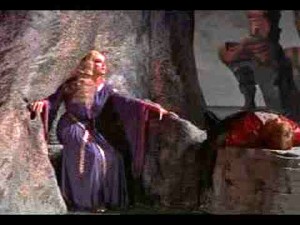
„Interrupted Melody“ Parker als Lawrence/Isolde/Screenshot/youtube
Unterbrochene Melodie (so der deutsche Filmtitel) ist ein biographischer Film aus dem Jahr 1955 über den Kampf der australischen Opernsängerin Marjorie Lawrence mit Kinderlähmung. Die Regie führte Curtis Bernhardt, die Hauptrollen spielten Glenn Ford, Eleanor Parker und Roger Moore. Der Traum der Australierin Marjorie Lawrence ist es, eine große Opernsängerin zu werden. Um diesen Traum zu verwirklichen, geht sie nach Paris und studiert Gesang. Dort wird sie nach einem grandiosen Auftritt entdeckt und steigt an der Metropolitan Opera in New York City zu einem Weltstar auf. Schon bald aber erkrankt sie schwer an Kinderlähmung und muss fortan im Rollstuhl sitzen. Doch durch den Zuspruch, den sie durch ihren Mann und ihre Verwandten erfährt, verliert sie die Hoffnung nicht und startet eine zweite Karriere. Der Film basiert auf der 1949 erschienenen Autobiografie Interrupted Melody von Marjorie Lawrence. Als die Verfilmung im Gespräch war, kündigte sie der Presse an, den Gesangspart übernehmen zu wollen, stattdessen wurde aber Eileen Farrell für die Gesangsszenen engagiert. Lawrence kritisierte den Film später als „unwahr“ gegenüber ihrem Leben. Der Film spielte an den US-Kinokassen ungefähr 1,8 Millionen Dollar ein.
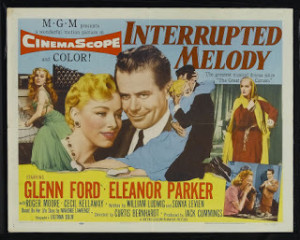 Der Soundtrack mit Eileen Farrell wurde am 20. September 1955 bei MGM veröffentlicht und enthält folgende Stücke: 1. Walzer der Musette (aus La Bohème), 2. Habanéra (aus Carmen), 3. Finale Act 1 (aus Il Trovatore), 4. „One Fine Day” (aus Madama Butterfly), 5. Séguidilla (aus Carmen), 6. Inmolation Scene (aus Götterdämmerung), 7. “My Heart At the Sweet Voice” (aus Samson et Dalila), 8. “Over the Rainbow” (aus The Wizard of Oz), 9. “Voi che sapete“ (aus Le Nozze di Figaro), 10. Medley: “Anchors Aweigh“, 11. Auszüge aus Tristan und Isolde). Der Film sammelte zahlreiche Preise und Oscars ein: Oscarverleihung 1956 für Oscar/Bestes Originaldrehbuch (William Ludwig), Oscar/Beste Hauptdarstellerin (Eleanor Parker), Oscar/Bestes Kostümdesign (Helen Rose). (Wikipedia)
Der Soundtrack mit Eileen Farrell wurde am 20. September 1955 bei MGM veröffentlicht und enthält folgende Stücke: 1. Walzer der Musette (aus La Bohème), 2. Habanéra (aus Carmen), 3. Finale Act 1 (aus Il Trovatore), 4. „One Fine Day” (aus Madama Butterfly), 5. Séguidilla (aus Carmen), 6. Inmolation Scene (aus Götterdämmerung), 7. “My Heart At the Sweet Voice” (aus Samson et Dalila), 8. “Over the Rainbow” (aus The Wizard of Oz), 9. “Voi che sapete“ (aus Le Nozze di Figaro), 10. Medley: “Anchors Aweigh“, 11. Auszüge aus Tristan und Isolde). Der Film sammelte zahlreiche Preise und Oscars ein: Oscarverleihung 1956 für Oscar/Bestes Originaldrehbuch (William Ludwig), Oscar/Beste Hauptdarstellerin (Eleanor Parker), Oscar/Bestes Kostümdesign (Helen Rose). (Wikipedia)
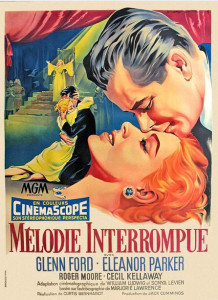 Eine Würdigung des Films erschien (neben vielen anderen) von der bedeutenden Filmkritikerin, Journalistin und Autorin Laura Wagner in den USA, die wir mit freundlicher Genehmigung von www.classicimages.com und dem Chefredakteur Bob King „nachdrucken“ – wir danken sehr!
Eine Würdigung des Films erschien (neben vielen anderen) von der bedeutenden Filmkritikerin, Journalistin und Autorin Laura Wagner in den USA, die wir mit freundlicher Genehmigung von www.classicimages.com und dem Chefredakteur Bob King „nachdrucken“ – wir danken sehr!
Nun also der Artikel von Laura Wagner zu Interrupted Melody: The Subject – Marjorie Lawrence was born in Victoria, Australia, on February 17, 1907, the daughter of farmer William Lawrence and Elizabeth Smith. Her vocalizing started early, and against the wishes of her father (her mother died when she was two), Marjorie ran away from home to pursue singing lessons in Melbourne. Her professional debut occurred in Monte Carlo playing Elisabeth inTannhäuser. She was an instant success. Afterwards, she appeared at the Paris Opera from 1933-38, and critics began hailing her as one of the great sopranos. She made her Metropolitan Opera debut in 1935 and was famous for riding her horse into the flames on stage in the finale of the opera Götterdämmerung.
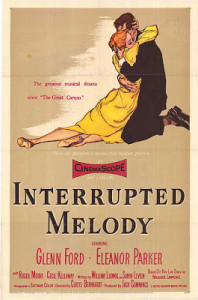 As a dramatic soprano and opera presence, Marjorie Lawrence had few equals, which the New York Times readily agreed, adding in 1935, “Her voice is a fine organ of great range and mettle.” With her popularity at its peak in 1941, she suffered a devastating blow to her personal and professional lives when she was stricken with polio just three months after her marriage to Dr. Thomas King. Lawrence managed to make a comeback, with the help of her husband, in 1942, singing at a concert at Town Hall. Although she made occasional singing engagements, however, Lawrence was never fully able to continue with a full-time opera schedule. But she carried on in great style. During World War II, she made a valiant tour for the troops, traveling 50,000 miles in the South Pacific, as well as entertaining in Europe – in her wheelchair. The 1960s onward saw her turning to teaching at various colleges, penning a book of poems (High on a Hilltop), hosting TV and radio shows, as well as participating in opera workshops near her home in Arkansas, which is where she passed away on January 13, 1979.
As a dramatic soprano and opera presence, Marjorie Lawrence had few equals, which the New York Times readily agreed, adding in 1935, “Her voice is a fine organ of great range and mettle.” With her popularity at its peak in 1941, she suffered a devastating blow to her personal and professional lives when she was stricken with polio just three months after her marriage to Dr. Thomas King. Lawrence managed to make a comeback, with the help of her husband, in 1942, singing at a concert at Town Hall. Although she made occasional singing engagements, however, Lawrence was never fully able to continue with a full-time opera schedule. But she carried on in great style. During World War II, she made a valiant tour for the troops, traveling 50,000 miles in the South Pacific, as well as entertaining in Europe – in her wheelchair. The 1960s onward saw her turning to teaching at various colleges, penning a book of poems (High on a Hilltop), hosting TV and radio shows, as well as participating in opera workshops near her home in Arkansas, which is where she passed away on January 13, 1979.
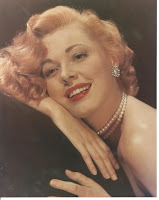
„Interrupted Melody“: Eleanor Parker/Pressefoto MGM
The Actress: The actress given the challenging role of Marjorie Lawrence in Interrupted Melody was the extremely versatile Eleanor Parker. She was born on June 26, 1922, in Cedarville, Ohio, and, like Lawrence, her interest in acting was planted at a young age. Eleanor was put under contract to Warner Bros. in 1941, and gradually became a star in The Very Thought of You (1944) and Pride of the Marines (1945). She proved her versatility and dedication to her craft in a variety of roles for Warners, in such films as Of Human Bondage(1946), The Voice of the Turtle (1947) and Caged (1950). She found her way to MGM in 1952, and while other actresses were finding it hard to obtain suitable roles in the ‘50s, Eleanor had no trouble acquiring major parts because of her flexibility as an actress. Besides Interrupted Melody, Eleanor did other fine work for both MGM and other studios on loan-out: Scaramouche (1952), The Man with the Golden Arm (1955) and Lizzie (1957). She was nominated for the Oscar three times: Caged (1950),Detective Story (1951) and for her part here in Interrupted Melody(1955). Later roles were geared more toward foreign and television productions. Parker remained active on TV and the stage until her retirement after Dead on the Money (1991), a cable film.
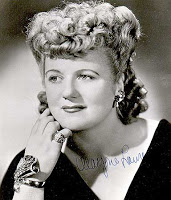
„Interrupted Melody“: Marjorie Lawrence/OBA
The Singer: One of the very best opera singers in recent recall, Eileen Farrell was called on to voice double Eleanor Parker, not even requesting screen credit for her very important contribution to the film. Eileen was born on February 13, 1920, in Willimantic, Connecticut. After high school, this fine soprano went to New York and tried out for Major Bowes’ amateur show, and failed; but, as one critic later noted, this was “perhaps because she could never be an amateur.” She bounced back and landed her first radio program in 1940 and her own show in 1942. She followed that with appearances on such shows as the popular The Prudential Family Hour. Singer Jack Smith, who also performed on this music show, marveled, “Eileen could sing ‘I Got a Right to Sing the Blues’ as well as she could sing a German round.” Her vocal diversity was well known: She recorded Irish songs, Broadway tunes, and pop songs, in addition to her opera repertoire. Concert singing started late for Miss Farrell, making her debut in 1947. She didn’t sing in an actual opera house until 1956, and she made her long overdue debut at The Met in 1960. Described by The New Yorker as “The finest dramatic soprano before the public,” theNew York Times went on to enthuse, “She can float long-breathed phrases of matchless quality, and she can vary her tone from fine-hued softness to a sumptuous fullness,” which could well speak for her work in Interrupted Melody.
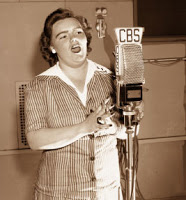
„Interrupted Melody“: Eileen Farrell/Foto CBS/OBA
Eileen recorded for Columbia records, doing both opera selections and pop standards. She continued to sing into the ‘90s on the Audiophile label, being one of the select opera singers to record jazz. Farrell happily retired in the late 1990s and wrote her autobiography (Can’t Help Singing). She passed away on March 23, 2002, at the age of 82.
The Film: Metro-Goldywn-Mayer bought the screen rights to Marjorie Lawrence’s book in 1952 and planned to star an unlikely Lana Turner. Greer Garson was then approached for the lead, and when that deal fell through, it was reported that singer Kathryn Grayson was in the running. In a later interview, Grayson explained that she did not get the role because Lawrence herself thought Grayson “too pretty,” which seems ludicrous. Although Grayson was a good singer and a presentable actress, she was never in the same league as Eileen Farrell or Eleanor Parker.
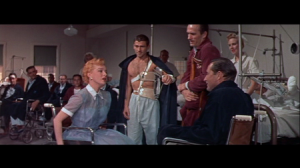
„Interrupted Melody“: Szene/Screenshot
Eleanor Parker was given the lead when she confronted producer Jack Cummings in his office. Cummings, according to columnist Sheilah Graham in Photoplay (August 1955), “was stuck for a leading lady, but he just couldn’t see Eleanor in the part of a prima donna because off-screen, Eleanor is quiet, conservative, and a devoted wife and mother to her three youngsters. But Cummings didn’t reckon with the determination of a woman who was after something she wanted – and Eleanor wanted to play Marj on the screen.“ Cummings was sitting behind his studio desk, slowly going over the list of possible candidates for the role when his door burst open, and in rushed a flamed-haired bunch of fury. He had to look twice before he even recognized Eleanor. She took the offensive and accused him of disliking her, said if she played the Lawrence role she would do thus and thus and then proceeded to show him. She exploded into a dramatic firecracker that would have done justice to Bernhardt. Infuriated by Ellie’s attack, Cummings replied that if she played the part she would do as he told her. Then he suddenly realized she had deliberately tricked him into seeing how temperamental she really could be when she set her mind to it.”

„Interrupted Melody“: Szene/Screenshot
It’s highly doubtful this scenario actually place, but it made excellent copy. However she got the part, Eleanor was in for a grueling study period to prepare for the role. The part was much more than just learning dialogue. She had to learn the musical arias, which were in different languages. “I had to be letter-perfect because while I didn’t actually sing the songs … the movement of my lips in forming the words had to ‘sync’ exactly with those of the great soprano’s as they came off the soundtrack. I learned three operas in three languages during two weeks.” Eleanor talked about how she accomplished the learning of the opera arias in another fan magazine interview: “I don’t have an opera voice, and I don’t speak all those foreign languages – what a challenge. I secluded myself in a mountain cabin at Lake Arrowhead [California] for ten days and listened to records day and night, learning 22 arias. For good measure, I had six lessons from MGM’s voice coach to help me with my lip synchronization.”
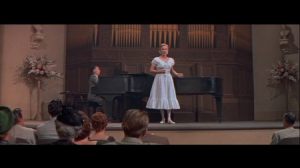
„Interrupted Melody“: Szene/Screenshot
For Photoplay, Eleanor revealed the off-camera motivation the role provoked: “I drove to work in the morning with the score propped up on the steering wheel of my car, and I woke up at night to find I’d been repeating the songs in my sleep.” Such dedication finally took its toll when she collapsed on the set and was rushed to the hospital suffering from exhaustion. Her faithfulness to her role paid off, with one reviewer raving, “She has mastered the mannerisms of her operatic roles so meticulously that it always seems that she is doing the singing.” Higher praise came from the singer herself, Eileen Farrell, who told me in 1998, “I remember the first time I saw the movie; I was out at MGM and they played it in a small studio for me. It never dawned on me once that it was me singing. Never once!”

„Interrupted Melody“: Szene/Screenshot
Farrell remembered the first time she met Eleanor. “She was making Many Rivers to Cross [1955] at the time I was doing the soundtrack. Every once in awhile she would appear in the control room, and she’d watch me and then she would have to leave because she’d have to go back to the other set. Later, she told me she almost had a nervous breakdown learning the whole damn thing because she had to learn the songs by playing my records. They put everything on records for her; when it was time for her to breathe, there would be a beep on the record so she knew that’s when she could breathe. But, she had to learn all those words, and she can’t sing a note. She was so damn smart. I think she’s a marvelous actress and a wonderful person. She worked very, very hard, but she learned every one of those [arias].”
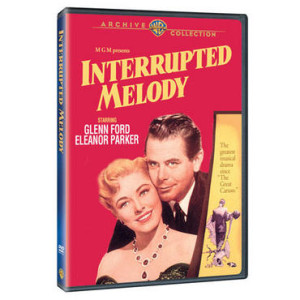 Initially, Marjorie Lawrence wanted to record the songs for the movie herself, but physically she was unable to do so at that point. “Jack [Cummings] had told me that Marjorie Lawrence wanted to do the singing, so they did one whole recording of the whole movie, and he said it was terrible,” Farrell revealed. “She said she wanted to do it with another conductor, so they did another whole recording. He said it was just as bad.” Screenwriter William Ludwig explained to author Doug McClelland in 1988 the behind-the-scenes vocal dubbing drama: “Marjorie Lawrence was supposed to do the singing … but the abdominal muscles were gone, and the repertoire too grueling. MGM approached Eileen Farrell, who was married to a New York City policeman and had refused to join the Met because she didn’t want to leave her husband and children. She agreed to do the singing for Eleanor Parker as Marjorie Lawrence on the condition that she get no publicity, because Lawrence was planning some concert tours and Eileen didn’t want to hurt Lawrence’s business by letting it be known that she wasn’t able to sing for her own life story. It was one of the most unselfish things I’ve ever seen in this business. Later, Lawrence herself spilled the beans when she sued MGM over not being allowed to sing in the film.”
Initially, Marjorie Lawrence wanted to record the songs for the movie herself, but physically she was unable to do so at that point. “Jack [Cummings] had told me that Marjorie Lawrence wanted to do the singing, so they did one whole recording of the whole movie, and he said it was terrible,” Farrell revealed. “She said she wanted to do it with another conductor, so they did another whole recording. He said it was just as bad.” Screenwriter William Ludwig explained to author Doug McClelland in 1988 the behind-the-scenes vocal dubbing drama: “Marjorie Lawrence was supposed to do the singing … but the abdominal muscles were gone, and the repertoire too grueling. MGM approached Eileen Farrell, who was married to a New York City policeman and had refused to join the Met because she didn’t want to leave her husband and children. She agreed to do the singing for Eleanor Parker as Marjorie Lawrence on the condition that she get no publicity, because Lawrence was planning some concert tours and Eileen didn’t want to hurt Lawrence’s business by letting it be known that she wasn’t able to sing for her own life story. It was one of the most unselfish things I’ve ever seen in this business. Later, Lawrence herself spilled the beans when she sued MGM over not being allowed to sing in the film.”
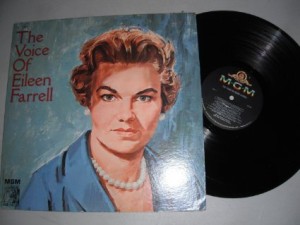
„Interrupted Melody“: Eileen Farrells Anteil am Film kam als LP bei MGM heraus
Lawrence was indignant and refused to believe she was incapable of doing the movie. Continued Farrell, “They told her that she couldn’t do the soundtrack, and she got very annoyed and very mad. At this point in her life she was into Jesus, and she told them, ‘If you do this without me, God will punish you!’ It was not [written] down in the contract that she had to do the soundtrack, so that’s why Jack [Cummings] waited for me. Jack had asked me to do [the movie] a long time before, but I was having my second child, and I couldn’t do it [then].” (Eileen was personal friends with Cummings’ wife and observed that the producer “was a lovely man, very quiet; a very gentlemanly-like person.”)
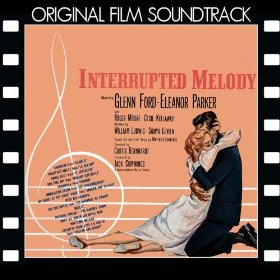 Recalling the recording session of the soundtrack, Eileen remembered, “I was supposed to be [at MGM] for three weeks, but I did the whole thing in one week. There were things that I knew, and when you know them, you know them. Out there at MGM they were used to splicing the tapes, putting them together for the voices, but they didn’t have to do that for me. So. I got through very early.” The recordings were supervised and conducted by Walter Du Cloux. Eileen recalls: “I’d known him a long time because I worked with him before. He was originally a ballet conductor, and we were good friends.”
Recalling the recording session of the soundtrack, Eileen remembered, “I was supposed to be [at MGM] for three weeks, but I did the whole thing in one week. There were things that I knew, and when you know them, you know them. Out there at MGM they were used to splicing the tapes, putting them together for the voices, but they didn’t have to do that for me. So. I got through very early.” The recordings were supervised and conducted by Walter Du Cloux. Eileen recalls: “I’d known him a long time because I worked with him before. He was originally a ballet conductor, and we were good friends.”
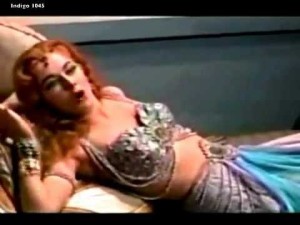
„Interrupted Melody“: Szene/Screenshot
The songs featured in the movie were diverse, to say the least. In addition to “My Heart at Thy Sweet Voice” (from Saint-Saens’Samson and Delilah), “Musetta’s Waltz” (from La Bohème), “One Fine Day” (from Madame Butterfly), the “Habanera” and “Seguidilla” (from Bizet’s Carmen), and “The Finale to Act I” (from Verdi’s Il trovatore), Farrell gets to show her vocal mettle and diversity by doing “Annie Laurie,” “Over the Rainbow,” “Waltzing Matilda,” “Anchors Aweigh,” and “Don’t Sit Under the Apple Tree.” For sheer variety, Eileen Farrell gives one of the greatest vocal performances in film musical history. It is a shame that it has been overlooked by film historians as such. It is also regretful that Interrupted Melodyis Farrell’s only film. “I don’t believe [Marjorie Lawrence] sang all those roles [in her career],” remarked Farrell. “Anyone in their right mind would not singCarmen, would not sing Wagner, La bohème. Those are all different kinds of voices. She was a dramatic soprano, and here she’s singingLa bohème, which is for a lyric soprano. I don’t believe she sang all those, but who am I to know? Just because I can do it!” she added with a wry laugh. (…)
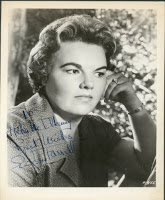
„Interrupted Melody“: die junge Eileen Farrell am Beginn der Karrierel/OBA
It was truly a sin that MGM failed to promote Parker’s Oscar nomination, and Anna Magnani won for The Rose Tattoo. William Ludwig noted, “I still believe that what helped our screenplay earn an Academy Award was the quality and substance which she gave to the starring role.” Besides the win for screenplay, Interrupted Melody received a nom for Helen Rose for her fabulous costumes, the most memorable being the beaded bikini for the Samson and Delilah number. William Tuttle did astonishing work on the make-up for Eleanor’s opera roles, especially his artistry in making her look like Carmen and Delilah. Interrupted Melody may be underappreciated today, but it has all the elements of a classic. This treasure of a film has never become dated; it’s as fresh and vibrant today as it was in 1955. Marjorie Lawrence may be somewhat forgotten today, but her inspiring film demands a reappraisal. Its melody, and memory, lingers on.
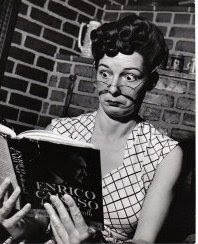
„Interrupted Melody“: Laura Wagner/Three wise Girls
Und das findet sich über die Autorin: Laura Wagner is resident film critic for Classic Images, the celebrated and iconic tome that is everything classic films. An avid movie watcher from her youngest years, Laura would take notes on movies—titles, actors, dates, other details. She had a notebook, she says, and each time she re-watched a movie, and she did that a lot, she’d review what she’d written, and mark off that she’d seen a movie again. During school lunch, every day, she’d read movie books. At home, once she’d done her homework, she’d read more movie books … and at quite a young age, she started to CORRECT some of the mis-information in some of these movie books. So begins the story of someone who’s lived and breathed movies most of her life. There’s virtually nothing Laura Wagner can’t recall about a movie. So it was that when she began reviewing movies for classic images years ago, she became quite the sensation in classic movie fandom. She also reviews books on the market about industry people—actors, producers, directors, collections and collectors … you name it—the wildly famous all the way down to the barely-known.
Ihr oben stehender Artikel findet sich auf diesem Blog. Die DVD gibts u. a. bei Amazon als preiswerten Import.

